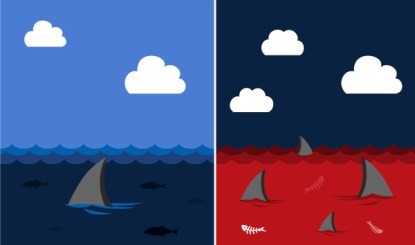Blue Oceans, Red Oceans, and Digital Marketing: Adapting Your Digital Strategy
‘Blue oceans’ and ‘red oceans,’ besides being highly compelling visual metaphors, are essentially slang terms for contested and uncontested markets. A blue ocean is a pristine, unchallenged market, free from competitors and saturation. The more competitive, congested industries are compared to red oceans, where sharks and predators fight amongst each other for dominance. Conceptualized in their 2005 book “Blue Ocean Strategy: How to Create Uncontested Market Space and Make the Competition Irrelevant” by W. Chan Kim and Renée Mauborgne, the strategy encourages businesses to consider branching out beyond traditional competition-centered markets and explore disruptive business ventures and innovative ideas.
While blue ocean strategy is most frequently used to encourage the creation of new business strategies or innovative projects, it has a less obvious but equally important application for marketing strategy. In fact, marketing strategy can take a product or concept that’s established or competitive and create a disruption which pushes it into a ‘blue ocean.’ Think of Starbucks, for example. While there certainly isn’t anything new about a coffee shop, the marketing of the Starbucks brand as a lifestyle and unique experience in addition to being a beverage retailer gave it an entirely fresh position, setting it in a market apart from other more traditional coffee chains.

Red Ocean Marketing
Traditional marketing, and even certain more outdated digital marketing strategies are examples of ‘red oceans.’ This style of marketing is highly responsive, focusing on competitive positioning within a strategic group and competition against rivals within the same industry. It also is highly responsive, adapting to external trends as they occur. While there is certainly value to adopting a more traditional market strategy, especially in financially difficult times where there is more financial risk associated with experimentation, this can be a ‘slow’ strategy, with more limited returns on efforts.
Applying Blue Ocean Strategy to Digital Marketing
Before the ubiquity of smartphones and a global digital consciousness, the obvious blue ocean strategy for marketing was to utilize websites and banner ads. As digital marketing has changed, SEO has evolved, and apps and social media have taken prominence, finding a niche for employing a digital marketing strategy isn’t quite as straightforward. What marketing professionals and businesses alike need to understand about blue oceans is that it doesn’t necessarily mean a complete innovation or invention of new techniques. In fact, just employing existing tools in an inventive way can differentiate a business enough to create a “blue ocean” in which they can succeed.
Where the blue oceans strategy can be applied for maximum impact in digital marketing is through original, dynamic content and innovative branding. Using a digital platform for marketing a business or project is no longer sufficient to create a distinctive niche that could be considered a “blue ocean.” Now, what matters the most is inventive marketing, branding and positioning using digital media as a platform.
Expanding on Existing Blue Oceans
Using Starbucks again as an example, they aren’t necessarily re-inventing the concept of digital marketing campaigns. What they do that seperates themselves from their competition is full integration digital marketing that supports their existing “blue ocean” as a lifestyle brand. With digitally available playlists curated for their target demographics, carefully targeted hashtags, a frequently updated app, and Instagram campaigns that further reinforce their position as a lifestyle and luxury brand, Starbucks doesn’t use digital media to create ‘blue oceans’ but to expand their existing position as innovators.
Creating New Blue Oceans
Certain digital marketing techniques can be used to create totally new blue oceans. Blue Apron, the recipe and food subscription service is an excellent example of digital presence creating unique opportunities. Completely web based, with a fully integrated app and responsive website, Blue Apron pioneered the concept of delivery-based meal subscriptions. Using Facebook and Instagram, the brand has spread quickly using hashtags, tailored ads and coupon codes for followers. While an app or a Facebook page isn’t exactly a revolutionary concept for marketing, the completely digital approach to marketing used by Blue Apron has helped them define their brand. Their brand is strong and sets them apart from competitors—fresh ingredients, access to an online community of home chefs, sustainability, and a service that is strongly linked to convenience and technology.
Thinking in terms of blue and red oceans can be a key tool for businesses or marketing professionals. While no marketing campaign is designed to be similar to everyone else’s, it is easy to use marketing as a means to comparing your product or service to the competition’s. The blue ocean strategy is an excellent way to move away from that method of thinking, and to use marketing as a way to create a fully unique, rich brand.
